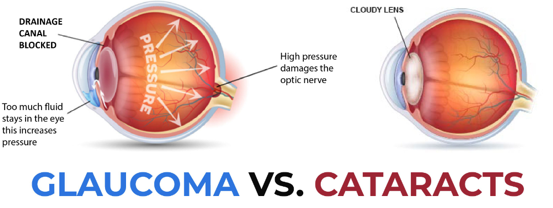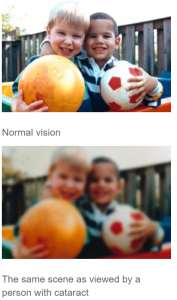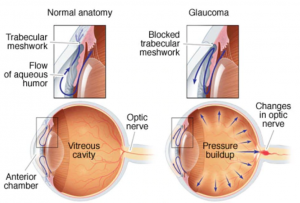
Cataract and glaucoma are diseases or conditions of an eye. Both of them are very common and prevailing globally. Here are some major differences and must know facts about cataract and glaucoma.
Table of Contents
Major differences between cataract and glaucoma are:
On the basis of |
Cataract |
Glaucoma |
| Definition | Cataract is the clouding of the lens of an eye. Looking through a clouded lens is like looking from a fogged window.
Initially, this clouding may only affect small portion of the eyes. However, later as cataract grows, it will cloud more portion of the lens and affects the light passing through the lens. |
Glaucoma is an eye disease/condition which causes damage to the optic nerve of an eye. |
| What it leads to | This condition leads to shadiness or obscuring of the lens, keeping light from separating back to the retina.
|
Glaucoma leads to loss of optic nerve tissue and vision misfortune.
|
| Causes | Causes of cataracts:
Although there may not be direct cause for cataract, the risk factors identified for cataract are:
|
Causes of glaucoma:
a) Increased/High Intraocular pressure (IOP), which damages the optic nerve:
Although, increased intraocular pressure is primarily responsible for glaucoma, there can be multiple reasons for increase in intraocular pressure. They can be:
|
| Physiological reason behind cataract and glaucoma | Cataract is linked with the clumping together of protein of the lens.
(Our lens is made up of protein and water. In normal condition, protein is arranged in such a way which keeps the lens clear and allows light to pass through it. However, under various conditions, protein may clump together and start to cloud the lens. This is cataract.) |
Glaucoma is linked with the built-up intra ocular pressure. This pressure damages the optic nerve, the nerve which transmits images to our brain. When optic nerve is damaged, there is no communication between eyes and the brain. |
| Types | Types of Cataracts
|
There are two basic kinds of glaucoma:
Additional types of glaucoma
|
| Description of types | a) Nuclear cataracts, that forms in the middle and move outward.
b) Cortical cataracts, which structure in streaks along the edges of the focal point and move internally. c) Congenital cataracts, which structure in utero or soon after birth. d) Posterior capsular cataracts, which structure at the base of the focal point’s case, and advancement quicker than different sorts do of cataracts. They may likewise frame as optional cataracts after beginning cataracts medical procedure. |
a) Primary open-angle glaucoma:
b) Acute angle-closure glaucoma:
|
| Symptoms | Most common symptoms of cataract are:
|
Symptoms of glaucoma may vary according to the type and stage of glaucoma.
For open-angle glaucoma, symptoms are:
For acute-closure glaucoma, symptoms are:
|
| Screening method | Most conventional method for screening cataract is regular testing of different parts of the eye and dilating pupil to check the lens. | One of the most common and conventional method for screening glaucoma is testing eye for high IOP (Intra Ocular Pressure). |
| Relationship between cataract and glaucoma | Cataracts do not cause glaucoma in essence, despite the fact that there are sure uncommon structures (outside the extent of this discourse) where the cataract is the causative factor of raised eye weight and harm to the optic nerve. | Glaucoma itself does not cause cataracts, despite the fact that there are sure circumstances wherein cataracts is exacerbated by medications for glaucoma. |
| Prevention measures | Prevention measures for cataract include:
|
Prevention measures for glaucoma include:
|
| Consequences | Whenever left untreated, cataracts can prompt visual impairment. Nevertheless, as referenced, the medical procedure can be performed. | Whenever untreated, glaucoma will cause visual impairment. Truth be told, this arrangement of conditions is the second driving reason for visual impairment in the United States. |
| Treatment | Cataract can be treated with the help of cataract surgery | Glaucoma can be treated through various surgeries like: Laser surgery, conventional surgery and drainage implants |
| Medical procedure |
|
Medical procedure for glaucoma is multifaceted however planned for lessening eye weight. These include:
a) Laser medical procedure: The laser-helped methodology is called laser trabeculoplasty, which helps channel liquid with a high-vitality laser shaft went for the trabecular meshwork. This might be more transitory than different methods. b) Ordinary medical procedure: This is a trabeculectomy, separating microsurgery that makes a waste fold enabling liquid to permeate out into the remainder of the vascular framework. c) Drainage implants: This is for grown-ups with uncontrolled glaucoma, auxiliary glaucoma, or youngsters with glaucoma. A silicone cylinder embedded into the eye coordinates the emptying liquids from the eye, assuaging weight. |
References and For More Information:
https://www.mayoclinic.org/diseases-conditions/glaucoma/symptoms-causes/syc-20372839
https://www.mayoclinic.org/diseases-conditions/cataracts/symptoms-causes/syc-20353790
https://www.allaboutvision.com/conditions/cataracts.htm
https://nei.nih.gov/health/cataract/cataract_facts
https://www.brightfocus.org/glaucoma/article/glaucoma-and-cataracts
https://www.webmd.com/eye-health/glaucoma-eyes#1
https://www.allaboutvision.com/conditions/glaucoma-2-cause.htm
https://www.healthline.com/health/glaucoma#types
https://www.glaucoma.org/glaucoma/cataracts-and-glaucoma.php
https://www.nvisioncenters.com/cataracts/vs-glaucoma/
https://www.webmd.com/eye-health/cataracts/what-are-cataracts#1

